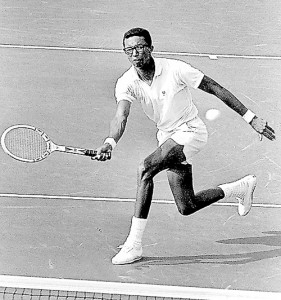Arthur Ashe inspired Afro-American tennis
View(s):Arthur Robert Ashe, the African American Tennis player who is in a class of his own, achieved great heights within the little space and opportunities available to him in the sixties. To honour him, the US-Open Tennis Stadium in Flushing Meadows, Corona Park, New-York was named ‘Arthur Ashe Stadium’ in 1997.
Ashe exalted world Tennis with his graceful presence and elegant skills. Unfortunately the Tennis world lost him too soon. Ashe appeared in an era in the sixties, when US Tennis was experiencing a decline after the feats of Tony Trabert in the 1950s. Ashe was not the first African American to make a mark in Tennis as there was Althea Gibson, a loner, who made her presence felt in the early fifties. Ash’s Tennis revived the African American Tennis for good. More African Americans played Tennis after Ashe and US Tennis bounced back to be recognised as the best. Today, the African American success in Tennis in the USA is dominant. With an African American as President, there is nothing unusual about it. When Ashe appeared in 1963, the sentiments were not in favour of African Americans. His peak years were in the back-drop of activist Martin Luther King’s death. He was the first African American to make it into the Tennis

Arthur Ashe exalted world Tennis with his graceful presence and elegant skills
team of the reputed Sports Academy of USA, the University of California, Los Angeles (UCLA). It was a ‘wonder team’, and each one made a strong impression in the Tennis world. Ashe progressed to win three of the majors including the US-Open. Harry Hopman of Australia who rolled out Australians Tennis players in numbers, ranked Ashe as number one. Ashe also led the US Davis Cup team for ten years, bringing the Cup home many times. So it is only natural that the US-Open Stadium bears his name. Ashe also graduated from UCLA in Business Administration.
Serve and Volley game
Born in 1943 in Richmond, Virginia he started to play Tennis at 7, won the National Junior Title at 17 as the first African American. Dr. Johnson was the man who supported, coached and addressed his personality development which gave him self-confidence which Ashe possessed and used well, in the latter years. To improve his game further Ashe went under Pancho Gonzales, another US tennis maestro and mastered the art of the ‘Serve and Volley game’. Ashe’s game improved with Gonzales’s contribution. Gonzales, who was a great player, teacher and popularised Tennis in the USA, is supposed to have said: “At the end of it, I was learning from him”. Ashe used this game to register most of his celebrated wins.
Wimbledon 1975
With his focus on the serve and volley game, his service improved tremendously. He has served 26 aces in some matches with a ‘wooden-racket’. It was not the era of super efficient aeronautic technology designed composites of 100 sq. inch rackets of today. Ashe played with a wooden racket of 90 square inches. Wooden rackets demand very high levels of perfection to play. His timing and co- ordinations must have been consistently perfect to get 25 plus aces in a match. In the latter years his intellectual ability made him versatile and showed his skill in almost every department of Tennis. Arthur Ashe’s most remembered win would be beating Jimmy Connors in the Wimbledon finals of 1975. Ashe was 32, ten years older than Connors. Connors was enjoying a 10/1 favourite position before the match. Ashe played a counter punching game to beat Connors. It was not his game but did what the situation demanded. This must have been most unexpected for Connors. Then the Wimbledon courts were not the genetically engineered slow grass of today. It was normal grass and very fast and with a semi skid for a bounce. There was only one other surface faster than grass then, which was indoor-wood.
ordinations must have been consistently perfect to get 25 plus aces in a match. In the latter years his intellectual ability made him versatile and showed his skill in almost every department of Tennis. Arthur Ashe’s most remembered win would be beating Jimmy Connors in the Wimbledon finals of 1975. Ashe was 32, ten years older than Connors. Connors was enjoying a 10/1 favourite position before the match. Ashe played a counter punching game to beat Connors. It was not his game but did what the situation demanded. This must have been most unexpected for Connors. Then the Wimbledon courts were not the genetically engineered slow grass of today. It was normal grass and very fast and with a semi skid for a bounce. There was only one other surface faster than grass then, which was indoor-wood.
‘British Movietone’ as the pre-movie news was a standard feature in Ceylon Theater Cinemas of Colombo then. It was the only possibility for us to see great players. Many would remember seeing Arthur Ashe as a lanky, graceful player generating power shots with the greatest of ease. Many writers, critics and commentators cite Arthur Ashe to be a graceful player. Ashe was the opposite of Jimmy Connors who exhibited his aggression openly.
Self Confidence and Post tennis era
Ash had a level of self confidence which was much higher than most. It is said that this was the secret behind Arthur Ashe’s success. Unexpectedly and to the surprise of many, he had a heart attack in 1979. Again, four years later, he contracted AIDS, through a contaminated blood transfusion. He lived his life as an activist from then on. Most of the AIDS awareness programmes bears his name. He was also an anti-apartheid activist for South Africans. Arthur Ashe passed away in 1992 in New York.
At Arthur Ashe’s peak he won 29 titles and had 108/23 win/loss record in one year. His UCLA team had Stan Smith, Bob Lutz, and Charlie Paserell. All of them became his mates in the US Davis Cup team and ended up in the top ten of the world. In his short life Ashe left enough when reminiscing about Tennis and also contributed to make the world a better place. US-Open naming the New York main stadium as ‘Arthur Ashe Stadium’ is a fitting testimony of his achievements.
- George Paldano, former international player; Accredited Coach of Germany, ITF and USPTR; National, Davis Cup and Federation Cup Coach
–gptennis.ceylon@gmail.com



